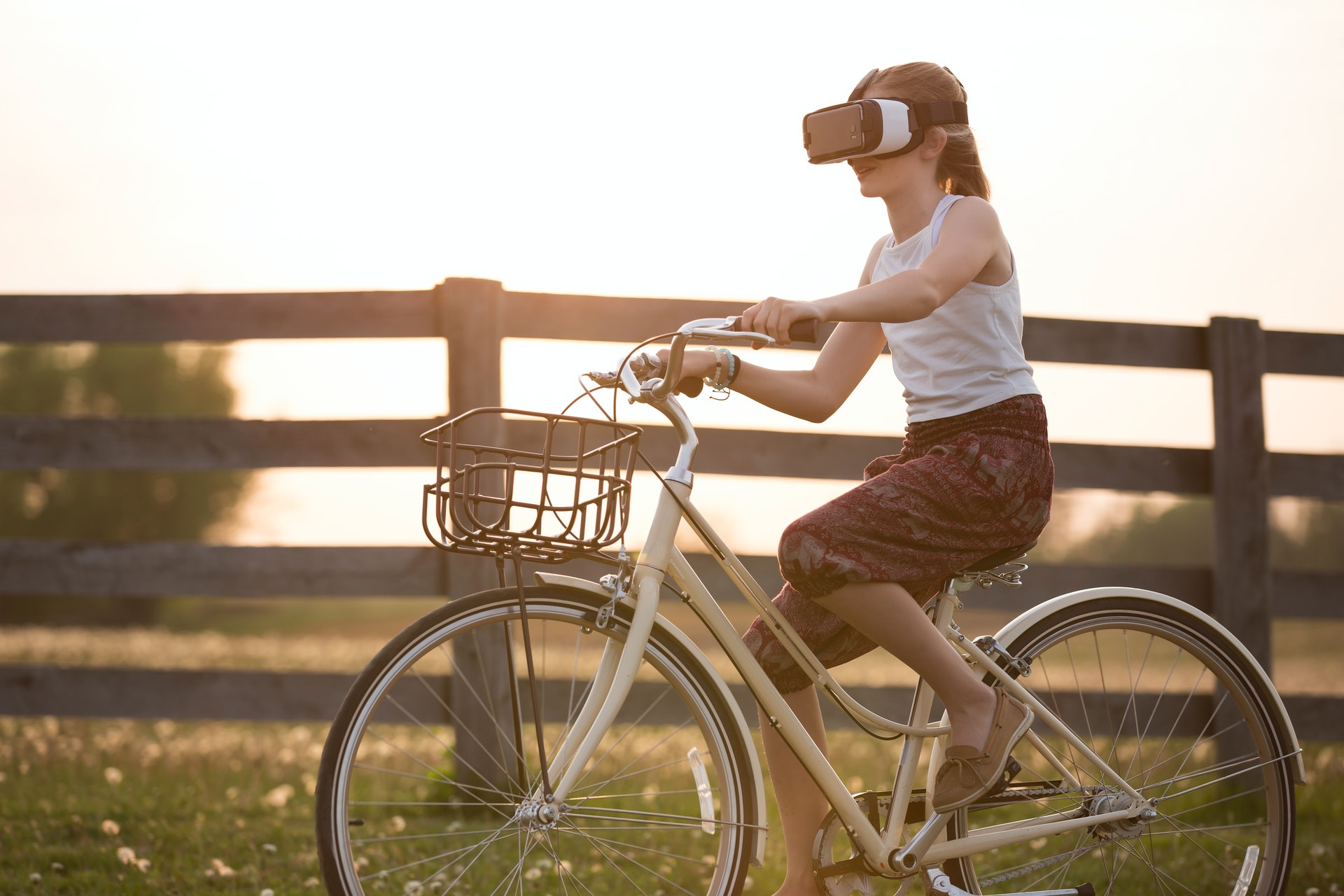What is Spatial Computing?
Spatial computing is the use of digital technology to interact with computers that understand their own use in space. As opposed to traditional computing, which is carried out behind a 2D screen, spatial computing leverages AR, VR, and MR to make a computer user interface a seamless part of our world.
An Overview of Spatial Computing
So, what does this unprecedented AR/VR/MR intelligence mean for businesses? Quite simply, it means that computers will become progressively more intertwined with – and understanding of – our real world thanks to a variety of advanced sensors, including cameras, situational awareness engines, and other exciting new technologies.
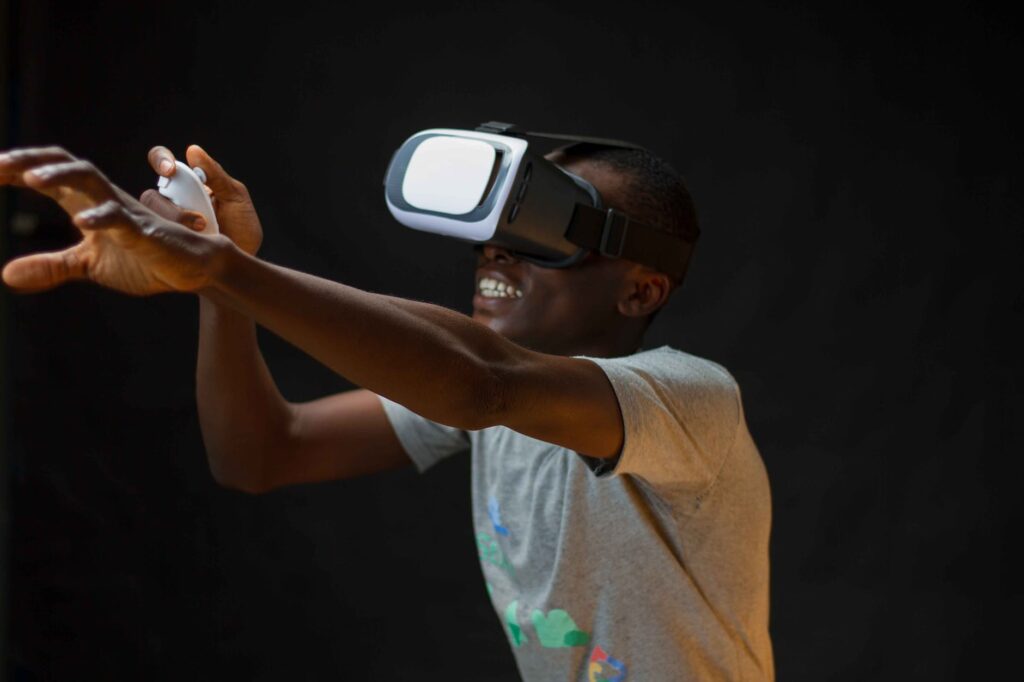
All of this can make the concept of spatial computing sound very next-generation, but the idea of this type of human-machine interaction, wherein machines can learn from and even repeat human actions, isn’t exactly new science.
Increasingly popular phrases like augmented, virtual reality, and mixed reality are the technologies most likely to grab the attention of today’s forward-thinking developers and business minds.
But there’s also an example of spatial computing that’s been around for years. You’ve likely used it earlier today.
GPS – the kind found in any smartphone – is yet another example of spatial computing, and it even predates the term being coined in 2003 by Simon Greenwold.
Spatial Computing and AR, VR, and MR
For anyone who understands or is involved with these technologies, the concept is fairly simple: spatial computing uses the physical space around us to interact with technology by sending inputs and receiving outputs through sensors and cameras so the computer understands its environment and its user.
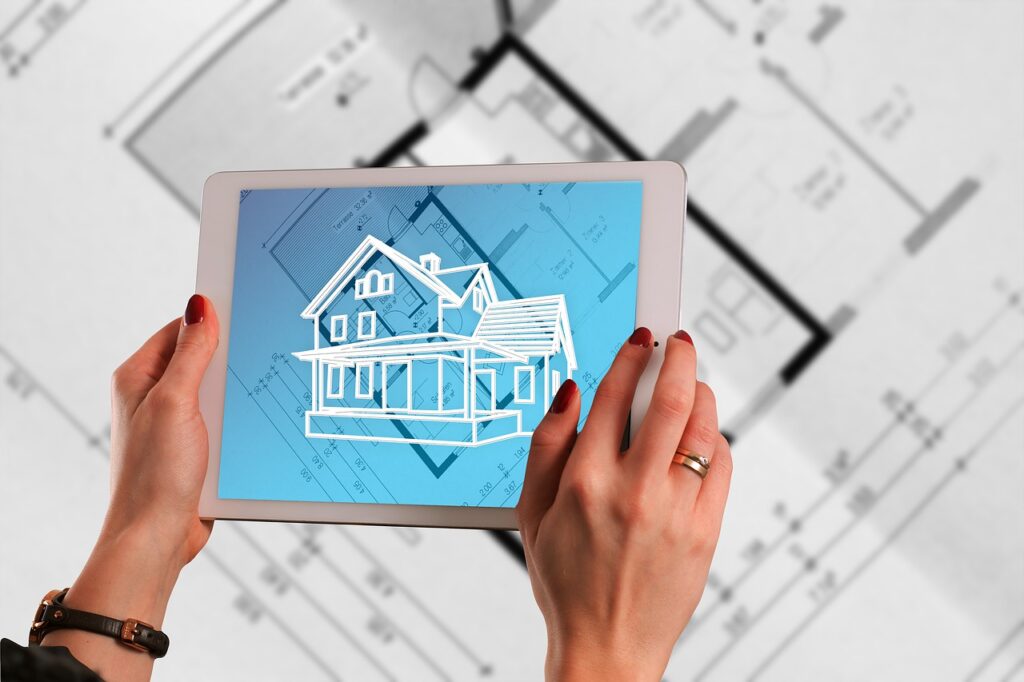
If you skew more on the business-side than the engineering-side of things, however, you might still be uncertain about what that exactly entails (as well as what it could mean for the future of businesses and practical applications alike).
Simply put, spatial computing literally means thinking outside the computer screen.
We’re no longer limited by the confines of our keyboard and mouse to give and receive information from a 2D screen. And, much like the trajectory of smartphones over the years, the hardware is shrinking to let the software lead the show.
Virtual reality, augmented reality, and mixed reality are all spatial computing areas where this is happening most prominently. But what exactly do those terms – VR, AR, and MR – mean?
VR vs. AR vs. MR
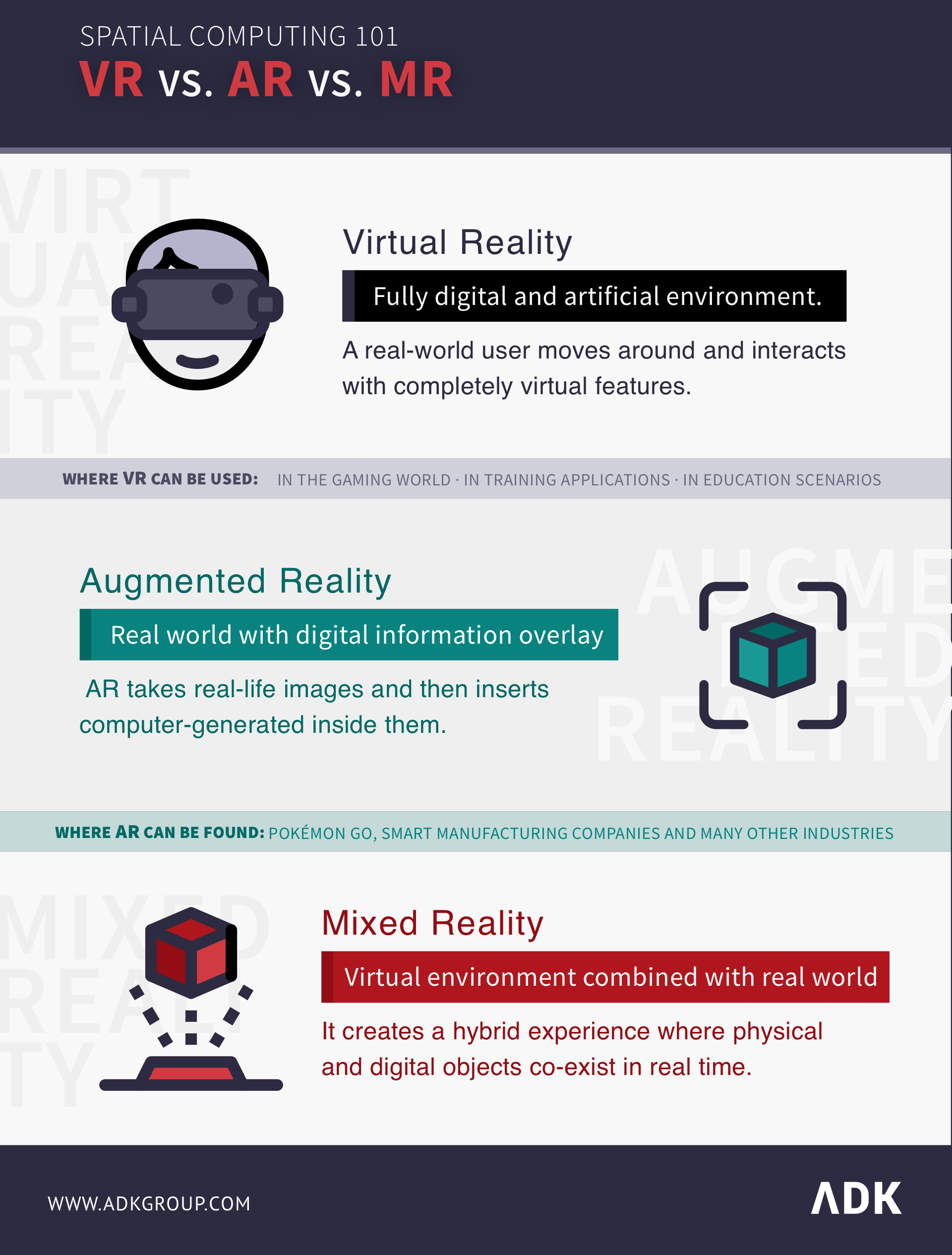
Virtual Reality (VR)
VR is a simulated experience that puts a user’s physical presence into an entirely artificial digital environment, allowing the user to move around, interact with, and see completely virtual features.
It can be used for entertainment such as gaming, but more and more, companies are leveraging VR for employee education and training, such as learning how to conduct operations in the medical field or work on engines in aerospace. Creating a simulated environment (cast through a VR headset) provides a risk-free way to conduct hands-on learning. This can be invaluable for otherwise dangerous or expensive learning programs.
Augmented Reality (AR)
Those familiar with VR often ask, “How is AR different from VR?” – and that’s a very fair question. AR and VR are often confused, but there are differences.
AR is a VR-style technology, but the difference between AR and VR is that rather than creating an entirely virtual world, AR takes a real-life image and inserts or projects computer-generated elements onto that image. Think Pokémon Go or Snapchat filters and lenses that allow you to alter your face or surroundings.
Another great example of how AR is being utilized within the entertainment realm can be seen in this video, which shows the development of a game designed to scan the surrounding environment of the player so it can create a complete picture, then allow the player to bring anything into their real world as an engaging obstacle or challenge:
AR technology is often executed through AR glasses, as seen in this blog chronicling ADK developer Matt Thompson’s experience at this year’s GlobalGameJam 2020. While in attendance, Matt and fellow ADK developer Rebecca Williams (along with the rest of their team) put together a Multipeer ARKit app using React Native called Reconstruct. However, it’s not just AR glasses that can execute and display this type of technology; in fact, it can sometimes be leveraged for smartphones and tablets as well – like in the case of Snapchat.
While AR is widely used for engaging consumers for entertainment purposes, it is quickly gaining ground in industries like aviation, healthcare, automotive, and even smart manufacturing to assist with everything from training to solutioning through enhanced natural environments. AR is an effective way to take a familiar environment and alter it to represent relevant changes or possible issues.
But remember, the images overlaid in AR are passive – meaning they don’t interact directly with the environment. If you want that, you should continue to the next section.
Mixed Reality (MR)
Here’s where things get really interesting. MR can be thought of as a combination of VR and AR; it essentially creates a hybrid experience where physical and digital objects can co-exist in real-time.
One prominent example of a mixed reality technology is Magic Leap, whose product, Magic Leap 1, is a wearable spatial computer that is truly demonstrating the shift from hardware to software for spatial computing. The company calls the product “the platform of the future for developing environment understanding, context awareness, and human-centered AI.”
The Spatial Computing Features That Bring it All to Life
- Light and Sound: Real-world lighting is merged with digital light in spatial computing to work with our eye-brain system in the same way as real life.
- Photography: Photos enable the spatial computing experience to accurately portray the measurements and depths of specific spaces, allowing a more realistic replication of an environment and, thus, a better response.
- Movement Trackers and Sensors: To make spatial computing possible, the devices they use are able to pick up on our eye movements, hand gestures, body movements and voice commands. Along with cameras and microphones, haptic gear like gloves or bodysuits send us tactile sensations like vibrations and air motion to make the experience real from a sensory perspective.
How Can I Leverage Spatial Computing for My Business?
Spatial computing technology is helping businesses in multiple industries train and educate employees, but there are even more ways to enhance your business model with this capability.
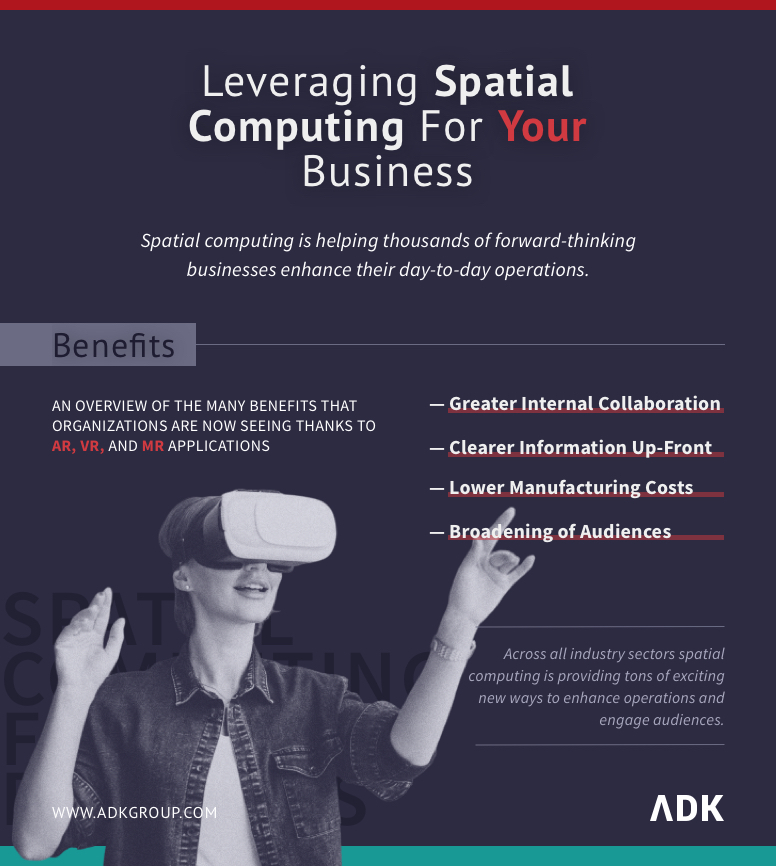
Here are some other benefits that a growing number of organizations are beginning to see thanks to spatial computing:
- Greater Collaboration: Say you operate an engine manufacturing company for aircraft and want to leverage the expertise of multiple employees for a single project. The only problem? The employees are on different continents. With spatial computing capabilities, those employees can put themselves in the same “room” and work together, hands-on, in a way that is simply not possible with standard collaboration tools like video conferencing. This capability can be useful for myriad industries that may be large, spread out nationally or globally, or deal in complex projects or solutions such as engineering or healthcare.
- Clearer Information: Spatial computing enables features like 3D visualizations of new concepts that can give an employee hands-on interaction with a product or solution before it has even been created in real life. This kind of experience can cut down on time and costs associated with product development, and accelerate implementation when employees are able to gain experience with the concept ahead of time. 3D visualizations are helpful for designing new technologies, software, manufactured parts or machines, as well as industries dealing in large projects like architecture or engineering.
- Broadening Audiences: As a consumer experience, spatial computing opens a new world of options for audiences to partake in. People can use spatial computing technologies to take college campus tours, or view a sporting event as though they have a seat in the stadium. Indeed, for the sports, media, entertainment, retail, and education industries (amongst others), spatial computing provides a wide opportunity to increase business in a new and exciting way.
Discover the Spatial Computing Solutions That ADK Can Create For You
Technology changes rapidly, and the advancements associated with spatial computing will continue to play a growing role in how we live. Needless to say, it’s a great idea to inquire about spatial computing sooner than later – or at least before your competitors do.
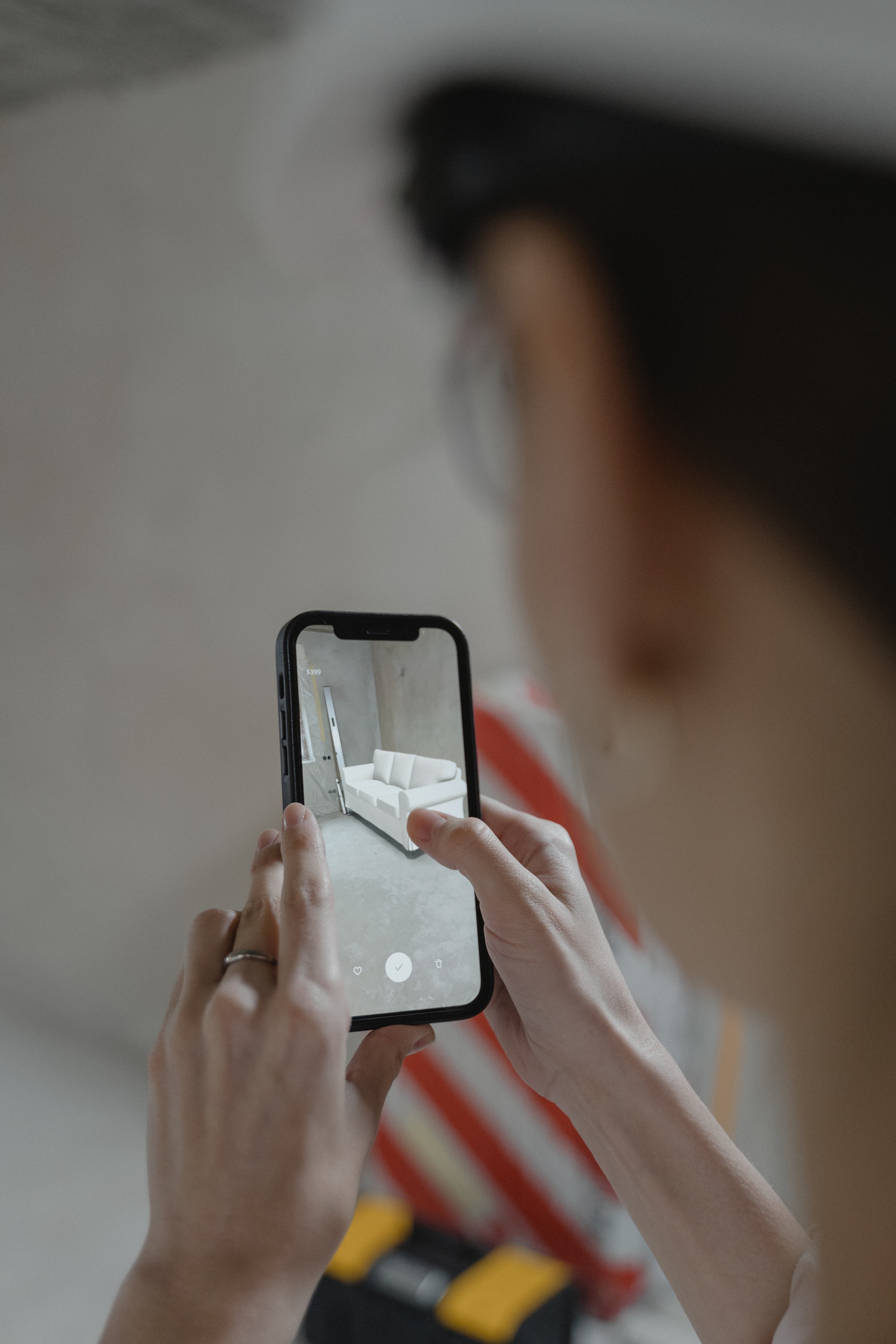
If you think any of the aforementioned spatial computing solutions make sense for your business – whether to optimize your internal workflows or the outgoing services you’re giving to customers – contact us to see how we can help bring digital experiences to your company’s reality.
